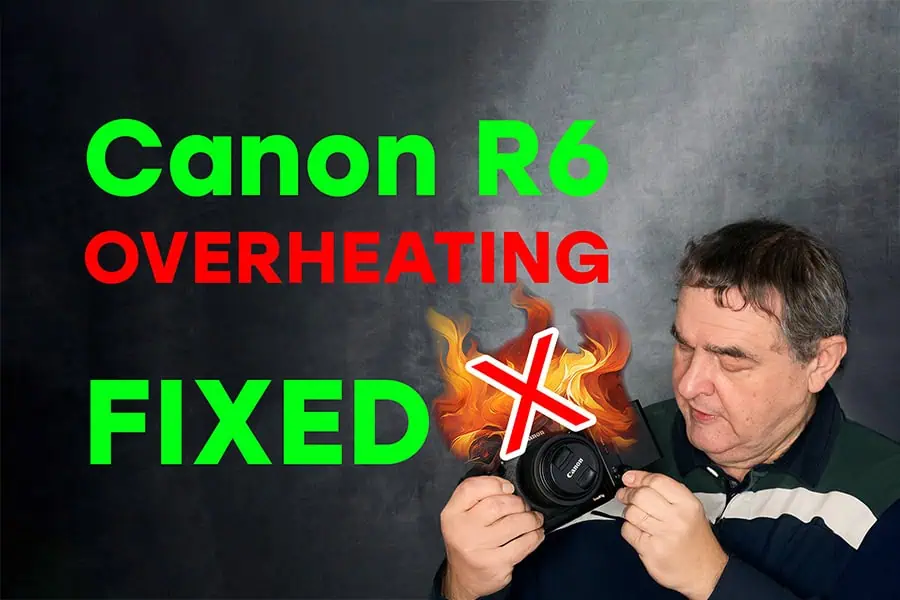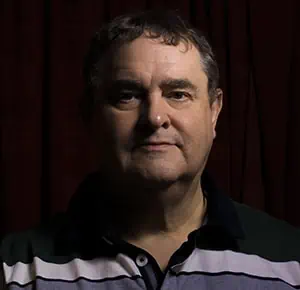DIY Video Studio is supported by its readers who use the affiliate links or ads on this site. As an Amazon Associate, I earn from qualifying purchases. Thank your support if you use any of the links.
Recently, I shot several customer testimonial videos in 4K for a client when the overheating warning on my Canon EOS R6 appeared. In fact, it appeared three times in five sessions during the day of the shoot. To say it was a little unnerving is a bit of an understatement, especially when the client was present. Upon returning to my studio, I tried and succeeded in solving my R6’s overheating problem. My solution let me shoot continuously for nearly three hours. Had I not filled up my SD memory card I suspect I could have carried on recording for much longer.
I created a YouTube video to share my solution with others and although it focuses on the R6, the solution should also work with other cameras struggling with overheating when recording in 4K. You can watch it in the YouTube player here or carry on reading for the details.
During my client shoot I was shooting 4K video at 25 frames per second, and each session was about half an hour long. That was fortunate, because although the overheating warning came on, my camera continued to record for long enough for me to capture the required footage. However, it was nerve-wracking to be partway through an unscripted interview, not knowing whether the camera would shut down before the end.
R6 Firmware update is a partial overheating fix
I knew that the R6 was prone to 4k overheating when running the original firmware and that Canon had released an update to mitigate the problem. The update improved shooting times before the camera would shut down, so I had kept my R6 firmware up to date and currently I’m using version 1.9.0.
By keeping my camera’s firmware up to date, I had hoped that overheating wouldn’t be a problem, especially since I work in Scotland, which isn’t exactly a hot country. If the update did help, it clearly didn’t eliminate the problem.
How long could I record before my camera overheated
When back in my studio I conducted some investigations to replicate the issue and see if I could work out a way forward.
To ensure my camera would overheat quickly, I changed the video quality to the highest setting: 4K 60 frames per second. And because the R6 has a 30-minute recording limit, I restarted the recording immediately after each automatic half hour stop. Unfortunately, I only needed to restart the recording once. The overheating warning appeared quite quickly, and the camera shut down after a total of around 40 minutes, even though the room temperature was only 19°C (66°F). But at least I now had a baseline for any solution to beat.
What was causing the R6 to overheat
To find a solution to the camera overheating, I needed to consider where the heat was coming from. These were what I considered to be the main sources.
The environment: the ambient air temperature and heat absorbed from direct sunlight. Obviously, shooting outdoors in a hot, sunny location will be worse than recording indoors in a cooler climate.
Heat generated by the camera’s electronics: This could include the image sensor, processor, display, and even the memory cards during data writing.
Battery discharge: When lithium-ion batteries are charged they heat up due to their internal resistance, but this also occurs during discharge.
So, we have three heat sources, but cameras act slightly like old fashioned storage radiators, the are heavy and will soak up heat but only release that heat slowly. The Canon R6, like the original R5, lacks cooling air vents and active cooling, so the heat builds up inside the camera, raising the temperature. Eventually, the camera will overheat and shut off.
Overheating solution options
So, what can we do?
We can’t control the ambient temperature unless we’re in an air-conditioned room, though we could shade the camera in bright sunlight. Realistically, shading the camera isn’t a practical solution. We need to keep the camera cool in another way or prevent heat generation in the first place.
To prevent heat generation by the screen and SD card writing, I could use an external field monitor and recorder, but I don’t want to spend that much. Having already spent thousands of pounds on the camera and lenses, my budget for the solution needs to be around £100.
Although the R6 does not include active cooling we can attach a cooling fan to the back of the camera. I found ULANZI make the CA25 Camera Cooling fan that fits in the camera’s LCD screen storage compartment.
The final option to prevent generating heat in the camera is to use external power. By using a dummy battery, we not only prevent heat being dumped into the camera body, but we can also use a higher capacity battery. This latter point is important since the goal is to keep shooting for longer without stopping. NP-F970 batteries for frequently used by videographers for LED lights and external power sources. Since I have several of these batteries will be my external power source.
Required accessories and set up to prevent camera overheating
I combined two approached, active cooling with a ULANZI CA25 fan and external power from an NP-F970 battery.
The ULANZI fane cost £30 in Amazon’s Black Friday sale, but it normally sells for £39 (in the USA the price just changes the pound sign for a dollar sign). It fits most cameras with a flip-out screen and has a built-in rechargeable battery. The battery provides 70 minutes of use on high speed or 85 minutes on low speed, but it can also be used with USB power for consistent fan speed and extended durations. The fan also has a digital display showing the fan speed mode and the temperature at the back of the camera.
The ULANZI CA25 Camera Cooling Fan is compatible with many cameras that have flip out screens. These include:
- Sony ZV-E1/ZV-1F/ZV-1/ZV-E10L/a7RV/a7 IV (A7M4)/a7S III A7S3)/A7C/FX30/A6700/A6500/A6400/a6000
- Canon R10/R8/R7/R6 Mark II/R6 MK1/R5/90D
- FUJIFILM XS10/XT4/X-H2S/X-S20/X-H2
- Nikon Z30 and more cameras
To use an NP-F970 battery to power the R6 camera I used the SmallRig power supply kit, since I already had it. For the NP-F batter I already had several PowerExtra NP-F 960/970 replacement batteries, each with a capacity of 8,800mAh or about four times the capacity of the standard Canon LP-E6NH camera battery.
The power supply kit includes everything needed to power the camera from the NP-F battery: an NP-F battery adapter plate, a dummy battery and cable for the R5 or R6 (it also fits my original EOS R and any other camera that uses the LP-E6 type of battery), and an L bracket. The bracket isn’t essential; you could attach the battery adapter plate to your camera rig or devise another holder.
You do not need the SmallRig power supply kit since the parts can be purchased separately. I found the NP-F battery plate adapter and an LP-E6 dummy battery for under £70 on Amazon. So, the fan and necessary parts cost around £100. I’m not including an NP-F battery in the cost, since I, and many videographers, already have several. However, if you need some, I found two PowerExtra NP-F970 batteries with charger on Amazon for around £43.
Setting up the external power involves attaching the battery plate to the L bracket, inserting the dummy battery into the camera’s battery compartment (using the hidden tab for the cable), and attaching the L bracket to the camera. Then, connect the dummy battery to the 7.4V socket on the battery plate (after waking it up with the red button) and attach the fan to the camera’s screen storage compartment (the spring slider will keep it in place). Finally, connect the fan to a power bank for consistent speed and extended use.
4k recording test result with cooling
- Without Fan (18°C Room Temperature): The camera shut down after 40 minutes.
- With Fan (18°C Room Temperature): The overheating warning appeared at 40 minutes, but the camera continued recording until 1 hour and 11 minutes. The indicated camera temperature on the fan display rose to 26°C and continued at that level for 20mins before the camera turned itself off.
- With Fan and External battery (20°C Room Temperature): The overheating warning never appeared, and I eventually stopped the test after 2h 44min because the SD memory card was full. The camera temperature initially dropped and then slowly increased during the test. At 2h 20min the camera temperature reached 21°C and remained there when I terminated the test.
Although just using the cooling fan made a difference to the available recording time, when it was combined with using external power was no longer an issue and provided stable performance for my Canon R6. The overheating warning light didn’t appear at all and the camera recorded for two hours and 44 minutes before stopping because the SD card was full.
Although this final solution did see the camera temperature rise, it was only to 21°C, significantly below the 26°C that caused the camera to shut down when only using the cooling fan. With the fan and external power, I shot for nearly two and three-quarter hours but suspect I could have continued for much longer since the camera temperature was staying well below the 26°C that saw the camera switch off before. The only limitations would be the SD card capacity and the NP-F970 battery life.
In this final test, I was shooting indoors at about 20°C and about 15 minutes short of three hours. In my work, I wouldn’t anticipate needing to record nonstop for so long. My only concern with this setup might be fan noise, which I’ll address next.
Audible fan noise
The ULANZI fan can run at two speeds, the highest mode being louder than low speed. Depending on you microphone placement, the fan noise may or may not be noticeable.
I conducted a subjective noise level test with the microphone in three positions. In the first case I used the internal microphones on the camera (something I wouldn’t normally do). Next, I mounted a Deity VidMic D3 mini shotgun microphone on the camera’s hot shoe. Lastly, I place a dynamic cardioid microphone close to me and about 4 or 5ft from the camera.
When recording with the internal microphones the fan noise was clearly noticeable. It was not as bad when recording with the on-camera shotgun microphone, but it could still be heard. But when I recorded with the microphone positioned away from the camera, I could not hear any fan noise on my recording.
Conclusion
In conclusion, the use of the ULANZI cooling fan, both on its own and in conjunction with external power, significantly improves the recording capabilities of the Canon R6 by mitigating overheating issues. While just the fan extends recording times to over an hour, combining it with external power ensures stable performance for many hours, with the camera temperature remaining well below problematic levels. Though the fan generates some noise, this is not a significant concern for professional setups or YouTube recording sessions, where external microphones positioned close to the speaker eliminate any noise being recorded. Therefore, these two solutions are highly effective for uninterrupted, long-duration recording.
About the author: Tosh Lubek is a multi-award-winning broadcaster, writer, and video producer, with 40 years of experience in professional broadcasting and has been using Canon video and stills cameras since 2010. He has worked with radio and TV broadcasters, advertising agencies, and direct clients on a variety of projects including radio and television advertising, online video production, corporate videos, award ceremony motion graphics, and theme park sound design. Tosh has won numerous awards, including a Radio Academy Awards Gold Sony, a Gold, Silver, and Bronze World Medals in the New York Festivals International Advertising Awards. Since about 2007 he has been creating YouTube videos. Tosh has been a sponsor of the “video booth” at HashTag Business Events across the UK.
Recent Posts
Why Every Photographer Should Have a Nifty-Fifty 50mm f/1.8 Lens
If there’s one lens nearly every photographer should own, it’s the 50mm f/1.8 - better known as the “nifty fifty.” This affordable lens provides impressive quality and versatility, making it...
The Ultimate Mic Pop filter and isolation hack: It’s NOT what you think!
Are you looking for an affordable, easy-to-implement hack to improve your audio quality for YouTube videos, voice overs, or podcasts? Well, it might surprise you, but fish tank filter foam should be...



